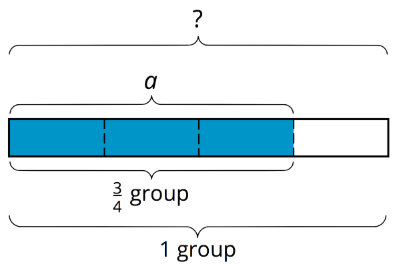23.2: Using an Algorithm to Divide Fractions
- Page ID
- 40246
Lesson
Let's divide fractions using the rule we learned.
Exercise \(\PageIndex{1}\): Multiplying Fractions
Evaulate each expression.
- \(\frac{2}{3}\cdot 27\)
- \(\frac{1}{2}\cdot\frac{2}{3}\)
- \(\frac{2}{9}\cdot\frac{3}{5}\)
- \(\frac{27}{100}\cdot\frac{200}{9}\)
- \(\left(1\frac{3}{4}\right)\cdot\frac{5}{7}\)
Exercise \(\PageIndex{2}\): Dividing a Fraction by a Fraction
Work with a partner. One person works on the questions labeled “Partner A” and the other person works on those labeled “Partner B.”
- Partner A:
Find the value of each expression by completing the diagram.
- \(\frac{3}{4}\div\frac{1}{8}\)
How many \(\frac{1}{8}\)s in \(\frac{3}{4}\)?

- \(\frac{9}{10}\div\frac{3}{5}\)
How many \(\frac{3}{5}\)s in \(\frac{9}{10}\)?

Use the applet to confirm your answers and explore your own examples.
Partner B:
Elena said: “If I want to divide 4 by \(\frac{2}{5}\), I can multiply 4 by 5 and then divide it by 2 or multiply it by \(\frac{1}{2}\).”
Find the value of each expression using the strategy Elena described.
- \(\frac{3}{4}\div\frac{1}{8}\)
- \(\frac{9}{10}\div\frac{3}{5}\)
- What do you notice about the diagrams and expressions? Discuss with your partner.
- Complete this sentence based on what you noticed:
To divide a number \(n\) by a fraction \(\frac{a}{b}\), we can multiply \(n\) by ________ and then divide the product by ________. - Select all equations that represent the statement you completed.
- \(n\div\frac{a}{b}=n\cdot b\div a\)
- \(n\div\frac{a}{b}=n\cdot a\div b\)
- \(n\div\frac{a}{b}=n\cdot\frac{a}{b}\)
- \(n\div\frac{a}{b}=n\cdot\frac{b}{a}\)
Exercise \(\PageIndex{3}\): Using an Algorithm to Divide Fractions
Calculate each quotient. Show your thinking and be prepared to explain your reasoning.
- \(\frac{8}{9}\div 4\)
- \(\frac{3}{4}\div\frac{1}{2}\)
- \(3\frac{1}{3}\div\frac{2}{9}\)
- \(\frac{9}{2}\div\frac{3}{8}\)
- \(6\frac{2}{5}\div 3\)
- After biking \(5\frac{1}{2}\) miles, Jada has traveled \(\frac{2}{3}\) of the length of her trip. How long (in miles) is the entire length of her trip? Write an equation to represent the situation, and then find the answer.
Are you ready for more?
Suppose you have a pint of grape juice and a pint of milk. You pour 1 tablespoon of the grape juice into the milk and mix it up. Then you pour 1 tablespoon of this mixture back into the grape juice. Which liquid is more contaminated?
Summary
The division \(a\div\frac{3}{4}=?\) is equivalent to \(\frac{3}{4}\cdot ?=a\), so we can think of it as meaning “\(\frac{3}{4}\) of what number is \(a\)?” and represent it with a diagram as shown. The length of the entire diagram represents the unknown number.

If \(\frac{3}{4}\) of a number is \(a\), then to find the number, we can first divide \(a\) by 3 to find \(\frac{1}{4}\) of the number. Then we multiply the result by 4 to find the number.
The steps above can be written as: \(a\div 3\cdot 4\). Dividing by 3 is the same as multiplying by \(\frac{1}{3}\), so we can also write the steps as: \(a\cdot\frac{1}{3}\cdot 4\).
In other words: \(a\div 3\cdot 4=a\cdot\frac{1}{3}\cdot 4\). And \(a\cdot\frac{1}{3}\cdot 4=a\cdot\frac{4}{3}\), so we can say that:
\(a\div\frac{3}{4}=a\cdot\frac{4}{3}\)
In general, dividing a number by a fraction \(\frac{c}{d}\) is the same as multiplying the number by \(\frac{d}{c}\), which is the reciprocal of the fraction.
Glossary Entries
Definition: Reciprocal
Dividing 1 by a number gives the reciprocal of that number. For example, the reciprocal of \(12\) is \(\frac{1}{12}\), and the reciprocal of \(\frac{2}{5}\) is \(\frac{5}{2}\).
Practice
Exercise \(\PageIndex{4}\)
Select all the statements that show correct reasoning for finding \(\frac{14}{15}\div\frac{7}{5}\).
- Multiplying \(\frac{14}{15}\) by \(5\) and then by \(\frac{1}{7}\).
- Dividing \(\frac{14}{15}\) by \(5\), and then multiplying by \(\frac{1}{7}\).
- Multiplying \(\frac{14}{15}\) by \(7\), and then multiplying by \(\frac{1}{5}\).
- Multiplying \(\frac{14}{15}\) by \(5\) and then dividing by \(7\).
- Multiplying \(\frac{15}{14}\) by \(7\) and then dividing by \(5\).
Exercise \(\PageIndex{5}\)
Clare said that \(\frac{4}{3}\div\frac{5}{2}\) is \(\frac{10}{3}\). She reasoned: \(\frac{4}{3}\cdot 5=\frac{20}{3}\) and \(\frac{20}{3}\div 2=\frac{10}{3}\).
Explain why Clare’s answer and reasoning are incorrect. Find the correct quotient.
Exercise \(\PageIndex{6}\)
Find the value of \(\frac{15}{4}\div\frac{5}{8}\). Show your reasoning.
Exercise \(\PageIndex{7}\)
Consider the problem: Kiran has \(2\frac{3}{4}\) pounds of flour. When he divides the flour into equal-sized bags, he fills \(4\frac{1}{8}\) bags. How many pounds fit in each bag?
Write a multiplication equation and a division equation to represent the question. Then, find the answer and show your reasoning.
Exercise \(\PageIndex{8}\)
Divide \(4\frac{1}{2}\) by each of these unit fractions.
- \(\frac{1}{8}\)
- \(\frac{1}{4}\)
- \(\frac{1}{6}\)
(From Unit 4.3.1)
Exercise \(\PageIndex{9}\)
Consider the problem: After charging for \(\frac{1}{3}\) of an hour, a phone is at \(\frac{2}{5}\) of its full power. How long will it take the phone to charge completely?
Decide whether each equation can represent the situation.
- \(\frac{1}{3}\cdot ?=\frac{2}{5}\)
- \(\frac{1}{3}\div\frac{2}{5}=?\)
- \(\frac{2}{5}\div\frac{1}{3}=?\)
- \(\frac{2}{5}\cdot ?=\frac{1}{3}\)
(From Unit 4.2.6)
Exercise \(\PageIndex{10}\)
Elena and Noah are each filling a bucket with water. Noah’s bucket is \(\frac{2}{5}\) full and the water weighs \(2\frac{1}{2}\) pounds. How much does Elena’s water weigh if her bucket is full and her bucket is identical to Noah’s?
- Write multiplication and division equations to represent the question.
- Draw a diagram to show the relationship between the quantities and to find the answer.
(From Unit 4.2.5)

